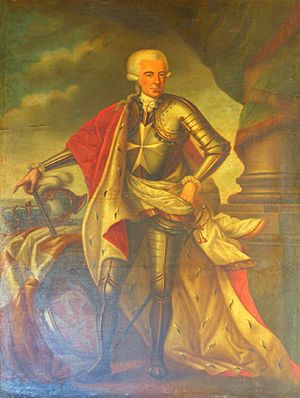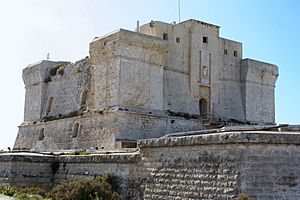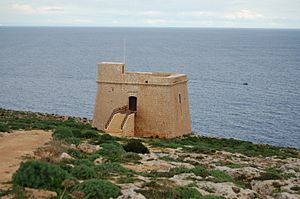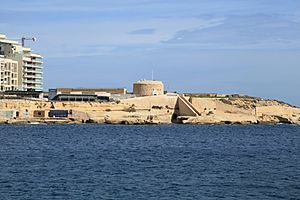French invasion of Malta facts for kids
Quick facts for kids French invasion of Malta |
|||||||||
|---|---|---|---|---|---|---|---|---|---|
| Part of the Mediterranean campaign of 1798 | |||||||||
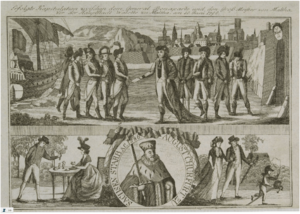 Engraving depicting Malta's capitulation to Napoleon |
|||||||||
|
|||||||||
| Belligerents | |||||||||
| Commanders and leaders | |||||||||
The French invasion of Malta was a quick takeover of the islands of Malta and Gozo. These islands were ruled by the Knights Hospitaller, also known as the Order of St. John. In June 1798, the French army, led by Napoleon Bonaparte, successfully invaded Malta. This event was part of a larger French military plan in the Mediterranean during the French Revolutionary Wars.
At first, the Knights and local Maltese soldiers tried to fight back. But in less than a day, the French took control of almost all of Malta. Only the heavily fortified harbour area, including the capital city Valletta, remained under the Knights' control. The Knights had enough supplies to last a long siege. However, problems like unhappiness among their own French members and the Maltese people led to a truce. This truce ended with the Knights giving up.
This invasion ended the Knights Hospitaller's 268-year rule in Malta. It led to the French occupation of Malta. A few months later, the Maltese people became unhappy with the new French rules. They started an uprising, which turned into a blockade of the French soldiers. The Maltese were helped by the British, Neapolitans, and Portuguese. The blockade lasted two years. In 1800, the French surrendered to the British. Malta then became a British protectorate, starting 164 years of British rule.
Contents
Why did the French invade Malta?
During the 1700s, the Order of St. John started to lose its power. Their main job of fighting Muslims was no longer as important. The Order began to rely heavily on France for money, and most of its members were French. After the French Revolution, the Order faced serious money problems by 1792.
Meanwhile, France and other big European countries became interested in Malta. The island was in a very important spot in the middle of the Mediterranean Sea. It also had some of the strongest forts in Europe.
By March 1798, the Knights knew that France was gathering many weapons in Toulon. However, they thought these weapons were for an attack on Portugal or Ireland. The Grand Master, Ferdinand von Hompesch zu Bolheim, did not believe Malta was in danger. He might have been told about the attack on June 4, but this is not certain.
How did the invasion happen?
French fleet arrives and demands water
The French fleet was seen near Gozo on June 6. Grand Master Hompesch called a meeting of his war council. He also called out the local militia, which were citizen soldiers. Maltese soldiers and militia, led by the Knights, were in charge of defending the fortified cities around the Grand Harbour. These included Valletta, Floriana, Birgu, Senglea, and Cospicua. Other towns and the coastline were to be defended by country militia and some Knights.
The French had already planned how to land and take over the Maltese Islands. On June 9, Napoleon sent his helper, Jean-Andoche Junot, to ask the Grand Master for permission. He wanted the French fleet to get fresh water in Malta. Hompesch held a council meeting to decide. They agreed to let only four ships at a time enter the harbours. This followed an old rule that said no more than four ships from Christian countries could enter Maltese ports during wartime.
On June 10, Napoleon sent a strong message to Hompesch. He said he was disappointed that the Order would not let more French ships in. He also mentioned the large French army and how useless any resistance would be. The letter asked Hompesch to make a deal to avoid fighting. It said the French would treat the Order as an enemy. But it promised to respect the religion, customs, and property of the Maltese people.
French forces land on Malta and Gozo
On the morning of June 10, the French began landing their soldiers. They landed in four different places on the Maltese Islands. These were St. Paul's Bay, St. Julian's, and Marsaxlokk on mainland Malta. They also landed near Ramla Bay on Gozo.
Landing at St. Paul's Bay
Troops led by Louis Baraguey d'Hilliers landed in St. Paul's Bay in northern Malta. The Maltese tried to fight back but quickly had to give up. The French took all the forts around St. Paul's Bay and nearby Mellieħa without losing any soldiers. The Maltese lost one Knight and one soldier, and about 150 Knights and Maltese were captured.
Landing at Marsaxlokk
A group of soldiers led by Louis Desaix landed at Marsaxlokk, a large bay in southern Malta. The landing was successful. The French managed to capture Fort Rohan after some fighting. After the fort was taken, the defenders left other forts along the coast. The French then landed most of their soldiers without any more resistance.
Landing at St. Julian's and taking Mdina
Soldiers led by Claude-Henri Belgrand de Vaubois landed at St. Julian's and nearby areas. Some ships from the Order's navy tried to stop them but failed.
Three battalions of French soldiers landed. They met some Maltese soldiers who offered a small fight before going back to Valletta. The French surrounded Valletta. Desaix's troops, who had landed at Marsaxlokk, joined them. The Knights and Maltese tried to counterattack. They sent soldiers against the French, who started to retreat. The Maltese advanced, but a French battalion ambushed them, causing confusion. The French then moved forward, and the defenders went back into the fortified city. The Order's flag was captured by the French.
With Valletta surrounded, Vaubois led some troops to the old city of Mdina. The remaining Maltese militia had gone there after the landings. At a city council meeting, they decided that fighting was useless. They agreed to surrender if their religion, freedom, and property were respected. By noon, the terms were agreed, and Mdina surrendered to Vaubois.
Landing and taking Gozo
The French force that landed on Gozo was led by Jean Reynier. Gozo was defended by about 2300 men. These included 300 regular soldiers, 1200 coastguards, and 800 militia.
The landing started around 1:00 PM near Nadur, between the Ramla Right Battery and the Sopu Tower. The defenders fired at the French, helped by cannons from Ramla and Sopu Tower. French cannons fired back at the forts. The French managed to move to higher ground despite heavy fire. The forts at Ramla were taken, and the French landed the rest of their troops.
Reynier and some of his soldiers marched to Fort Chambray. This fort controlled Gozo's main harbour, Mġarr. They wanted to cut off communication with Malta. The fort was full of people seeking safety from nearby villages. It surrendered around 2:00 PM. Meanwhile, the rest of Reynier's soldiers marched through Xagħra to the Cittadella in the capital, Rabat. A group of soldiers took over the Marsalforn Tower. The Cittadella surrendered by nightfall. The French captured many cannons, muskets, gunpowder, and wheat.
What happened in the harbour area?
After the successful landings, there was a lot of chaos and unhappiness in Valletta and the Cottonera area. The Grand Master and his council stayed at the Palace. Priests organized parades with the statue of Saint Paul, praying for help. Two Frenchmen in the city were killed because people thought they were involved in the invasion. People feared that prisoners might revolt. Fears of a Maltese uprising against the Order grew after two young Knights were killed.
Inside the city, some people supported the French, while others were against them. Some French Knights had ideas similar to the French Republic and supported Napoleon. Jean de Bosredon de Ransijat, an important Knight, was put in prison. He had written to Hompesch saying he would not fight the French and wanted to stay neutral. Some people pressured Hompesch to talk with Napoleon and make peace. Maltese representatives also asked the Grand Master to agree to a ceasefire.
Meanwhile, the forts in the harbour area kept fighting. Fort Ricasoli and Fort Manoel resisted many attacks. They only surrendered after the Order had officially given up. The French surrounded Fort Tigné and attacked it repeatedly on June 11 and 12. The soldiers defending Tigné did not know about the peace talks happening. The defenders left Tigné on the night of June 12–13, and the French took control soon after.
How did the Knights surrender?
The Council finally decided to ask for a truce, which is a temporary stop to fighting. A Dutch consul was first chosen to deliver a letter asking for a truce. Because he was old, a staff member was sent instead. He arrived on the French flagship L'Orient at 9:00 AM on June 11. He returned with a message that Napoleon would send someone to talk. Around noon, General Junot arrived with a small group. He was joined by some Knights who supported the French, including Ransijat, who had been freed.
Hompesch and other leaders met the French envoys. They agreed to stop fighting for 24 hours while talks continued on L'Orient. On June 12, Napoleon and representatives from the Order and the Maltese signed an agreement. In this agreement, the Order gave up Valletta and all of Malta's forts. They also gave control of the islands to the French. The French promised to get a new territory for the Grand Master as payment for losing Malta. They also promised to respect the private property of the Knights and the Maltese people. Pensions were given to the Grand Master and French Knights.
The agreement stated that several forts and lines of defense were to be given to the French by noon on June 12. These included Fort Manoel, Fort Tigné, Fort St. Angelo, and the forts of Birgu and Senglea. The remaining forts, like those in Valletta and Fort Saint Elmo, were to be given up by noon the next day. The Order's navy was also to be handed over by June 12. By June 12–13, the French had taken control of the entire island and all its forts. They also captured about 1200 cannons, 40,000 muskets, a lot of gunpowder, two large ships, a frigate, and four galleys from the Order.
What happened after the invasion?
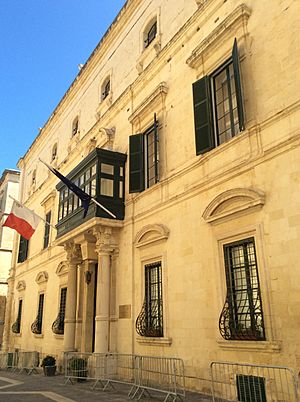
After taking Malta, Napoleon arrived in Valletta on June 13. He stayed on the island for six days. He spent the first night at the Banca Giuratale and later at Palazzo Parisio. Then, most of the French fleet left for the campaign in Egypt. General Vaubois stayed on the island with soldiers to keep control. This began the French occupation of Malta. During his short stay, Napoleon made many changes to Malta's government and society. He wanted to make them like the ideas of the French Republic.
A few days after the surrender, the Grand Master and many Knights left Malta. They took some of their belongings, including religious items. The Order found safety with Paul I of Russia, who was later declared Grand Master by some Knights. The Order slowly changed into the Sovereign Military Order of Malta, which still exists today. It has its own rules but no land.
Most Maltese people were happy when the Order was expelled at first. They liked the French. But this changed when the French refused to pay the Order's debts. They also brought in new taxes, stopped paying pensions, and limited the Church's power. They even started taking things from churches. Within three months, the Maltese rose up against the French. They took control of most of the islands, with help from the British, Neapolitans, and Portuguese. The French soldiers in Valletta and Cottonera held out for two years during the blockade. Finally, Vaubois surrendered to the British in 1800. This made Malta a British protectorate, starting 164 years of British rule.
See also
 In Spanish: Invasión francesa de Malta para niños
In Spanish: Invasión francesa de Malta para niños


